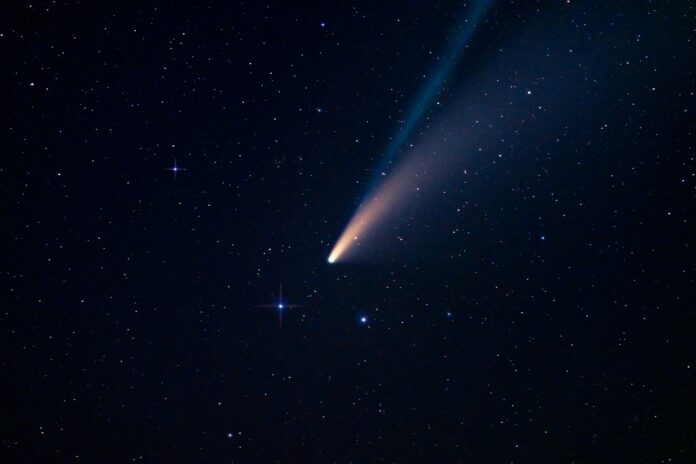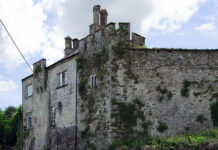
THE celestial wonders of the night sky have fascinated humanity for centuries. Throughout history, rare events in the cosmos have ignited curiosity and inspired both awe and speculation. One such event occurred in the summer of 1856 when an apparent sighting of a comet over the skies of Limerick created a sensation that quickly spread across the globe, capturing imaginations far and wide.
The account of this celestial occurrence was first chronicled in the Limerick Observer on August 2, 1856, marking the beginning of a story that would make its way into various newspapers and publications around the world, from Tasmania’s The Hobarton Mercury to the illustrious New York Times.
While most sources reported the marvel of the sighting, there were some sceptics. In England, The Spectator expressed doubt about the news, stating that “whether the comet has come or not, they seem to have a private conviction, in Ireland at least, that he has visited that favorited isle.”
The Limerick Observer‘s article recounted the experiences of a “gentleman of the highest respectability” during a three-day period that transpired in Limerick that summer.
A gentleman and his friend
The events began on Wednesday July 30, 1856, around 10:30pm when the gentleman and a friend found themselves near the Lax Weir in Corbally.
His attention was suddenly captivated by what appeared to be a fire on the summit of Keeper Hill to the east in Tipperary. This supposed fire did not behave as expected; it started ascending into the night sky. The friend thought it might be a lantern suspended from a kite.
This celestial anomaly was later described as “a globe of fire as large as a good-sized orange with a broad tail of light extending about 18 inches.”
The Monmouthshire Merlin, a publication of the time, painted a vivid picutre, writing that “the comet has been seen with a thundering tail standing out like that of a Kilkenny cat in a fearful passion, every hair at a right angle with the line of the caudal appendage.”
Undoubtedly, a colourful and imaginative description. However, another account described it as having a brilliant red body with pale blue tinges.
The two men at the Lax Weir observed this remarkable spectacle for approximately an hour, as did the two watchmen on the weir before retiring for the night.
On the following evening, the same gentleman returned to the same location, this time accompanied by his sister. They claimed this time to have seen the comet again, though it was positioned higher in the night sky compared to the previous evening. Their observation of the celestial visitor concluded at 11:30pm on the second night.
On the subsequent Friday night, the enigmatic comet once again graced the night sky, making its appearance at 10:40pm and remaining visible until 1:30am.
A Newtonian letter
As reports of this celestial display spread, it came to be seen as an auspicious omen, heralding a new era marked by “seven years of prosperity and abundance”. Such celestial occurrences often carried deep significance for people, influencing their beliefs and actions.
The news of this comet over Limerick emerged exactly 300 years after the Great Comet of 1556. So there were many people with their eyes to the sky during this period in the hope that the Great Comet would return as the English astronomers of the time, Richard Dunthorne and John Russell Hind, theorised that comets followed a 300-year cycle.
The Limerick sighting did not find its way into the scientific journals of that era and there was doubt at the validity of the sighting.
A few weeks later a letter appeared in the Daily Express by someone signing themselves ‘A Newtonian’ from Inniskeen. The letter claiming that this comet was no more than Jupiter playing tricks in the sky. The editor of the newspaper agreed with the Jupiter theory as “during the present hot weather, the strong gaseous exhalations from the earth will frequently form lens like medium”.
Whether or not it was merely the largest planet in the solar system, the celestial event of 1856 in Limerick ignited the collective imagination, captivating individuals and societies worldwide. This event added to the rich tapestry of human fascination with the cosmos and its enduring mysteries.
The name of this local gentleman was never published, but it could have been a local star gazer Richard Wallace.
Wallace was a silversmith and jeweller who was fascinated by the night sky. In 1841, he opened his new store on the ground floor of his house on George Street (O’Connell Street). On the front façade of the house he embedded a large clock, while on the roof he built an observatory.
From his observatory, he would gaze at the stars and take daily readings of temperature and air pressure. These readings were often published in the Limerick Chronicle in the mid-nineteenth century.
When he heard about Hampden W Russell’s impending flight on a hot air balloon on September 3, 1849, he gave Russell a barometer “for the purpose of getting for him its indication at the greatest altitude” while on board.
Still, just as the truth behind the comet remains a mystery, the name of the gentleman, his friend, and sister also remain as secrets.










